
Earthquake: An earthquake measuring 7.8 on the Richter scale ravaged Turkey and Syria on Monday (6 February), killing more than 4,000 people in both countries. Apart from claiming human lives, the earthquake brought down thousands of buildings over a wide area in the two West Asian countries. Meanwhile, Turkish President Recep Tayyip Erdogan declared seven days of national mourning.
The epicenter of the earthquake was in Turkey’s southeastern province of Kahmanmaras. According to reports, the three back-to-back tremors sent residents of Damascus and Beirut off the street and were felt as far as Cairo.
Meanwhile, thousands of buildings were reportedly reduced to rubble across a wide area stretching from the cities of Aleppo and Hama in Syria to Diyarbakir in Turkey. Rescue operations are underway as one of the most powerful earthquakes in the region in at least a century wiped out entire sections of major cities in both countries.
Here is a list of some of the world’s deadliest earthquakes since 2000:
- January 26, 2001: A 7.7 magnitude earthquake struck Gujarat, India, killing 20,000 people.
- March 25, 2002: Nearly 1,000 people were killed in a 6.1 magnitude earthquake in northern Afghanistan.
- May 21, 2003: More than 2,200 people were killed in a 6.8 magnitude earthquake in Algeria.
- December 26, 2003: A 6.6 magnitude earthquake hits southeastern Iran, killing 50,000 people.
- 26 December 2004: A magnitude 9.1 earthquake in Indonesia triggered a tsunami in the Indian Ocean, killing 230,000 people in a dozen countries.
- March 28, 2005: An 8.6-magnitude earthquake struck northern Sumatra in Indonesia, killing nearly 1,300 people.
- October 8, 2005: More than 80,000 people were killed in a 7.6 magnitude earthquake in Pakistan-occupied Kashmir.
- May 26, 2006: A 6.3-magnitude earthquake struck Indonesia’s Java island, killing more than 5,700 people.
- August 15, 2007: A magnitude 8.0 earthquake near the coast of central Peru has killed more than 500 people.
- May 12, 2008: A magnitude 7.9 earthquake struck eastern Sichuan, China, resulting in the deaths of over 87,500 people.
- April 6, 2009: A 6.3 magnitude earthquake in and around L’Aquila in Italy killed more than 300 people.
- 30 September 2009: A 7.5-magnitude earthquake has killed more than 1,100 people in southern Sumatra, Indonesia.
- January 12, 2010: An astonishing 316,000 people were killed by the magnitude 7.0 earthquake in Haiti.
- February 27, 2010: An 8.8 magnitude earthquake rocks Chile, generating a tsunami and killing 524.
- March 11, 2011: A magnitude 9.0 earthquake off the northeast coast of Japan triggers a tsunami, killing more than 20,000 people.
- September 24, 2013: A 7.7 magnitude earthquake struck southwest Pakistan, killing over 800 people.
- 3 August 2014: More than 700 people have died in a 6.2-magnitude earthquake near Wenping, China.
- April 25, 2015: More than 8,800 people have died in the 7.8 magnitude earthquake in Nepal.
- August 24, 2016: More than 300 people have died in a 6.2 magnitude earthquake in central Italy.
- September 28, 2018: A 7.5 magnitude earthquake hits Indonesia, killing more than 4,300 people.
- August 14, 2021: A 7.2 magnitude earthquake in Haiti killed more than 2,200 people.
- June 22, 2022: More than 1,100 people have died in a 6.1 magnitude earthquake in Afghanistan.
What causes earthquakes?
It should be mentioned here that an earthquake occurs due to sudden sliding on the fault. Tectonic plates always move slowly, but they get stuck at their edges because of friction. When the stress on the edge overcomes the friction, an earthquake occurs that releases energy in waves that travel through the Earth’s crust and cause vibrations. Earthquakes usually depend on the geographic settings and movement of tectonic plates. In the case of Turkey, it is located primarily on the Anatolian Peninsula in Western Asia.
(with inputs from AP)
Read also: Explained: Why Turkey is prone to the deadliest earthquakes in the world; lessons to be learned
Read also: Turkey Earthquake LIVE UPDATE: India sent first consignment of relief material; death toll 4,000